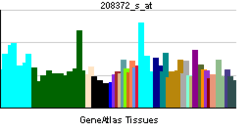LIM kinase-1 (LIMK1) and LIM kinase-2 (LIMK2) are actin-binding kinases that phosphorylate members of the ADF/cofilin family of actin binding and filament severing proteins. ADF/cofilin are the only substrates yet identified for the LIM kinases. Upstream, LIMK1 is regulated by Pak1,[1] and LIMK2 by the Rho-dependent kinase ROCK.[2] Lim Kinases are activated by PAK (p21-activated kinase).
There are approximately 40 known eukaryotic LIM proteins, so named for the LIM domains they contain. LIM domains are highly conserved cysteine-rich structures containing 2 zinc fingers. Although zinc fingers usually function by binding to DNA or RNA, the LIM motif probably mediates protein-protein interactions. LIM kinase-1 and LIM kinase-2 belong to a small subfamily with a unique combination of 2 N-terminal LIM motifs and a C-terminal protein kinase domain. LIMK1 is likely to be a component of an intracellular signaling pathway and may be involved in brain development. LIMK1 hemizygosity is implicated in the impaired visuospatial constructive cognition of Williams syndrome.[3]
References [link]
External links [link]
- Lim+Kinases at the US National Library of Medicine Medical Subject Headings (MeSH)
https://wn.com/Lim_kinase

LIMK1
LIM domain kinase 1 is an enzyme that in humans is encoded by the LIMK1 gene.
Function
There are approximately 40 known eukaryotic LIM proteins, so named for the LIM domains they contain. LIM domains are highly conserved cysteine-rich structures containing 2 zinc fingers. Although zinc fingers usually function by binding to DNA or RNA, the LIM motif probably mediates protein-protein interactions. LIM kinase-1 and LIM kinase-2 belong to a small subfamily with a unique combination of 2 N-terminal LIM motifs, a central PDZ domain, and a C-terminal protein kinase domain. LIMK1 is likely to be a component of an intracellular signaling pathway and may be involved in brain development.
Clinical signficance
LIMK1 hemizygosity is implicated in the impaired visuospatial constructive cognition of Williams syndrome.
Interactions
LIMK1 has been shown to interact with:

